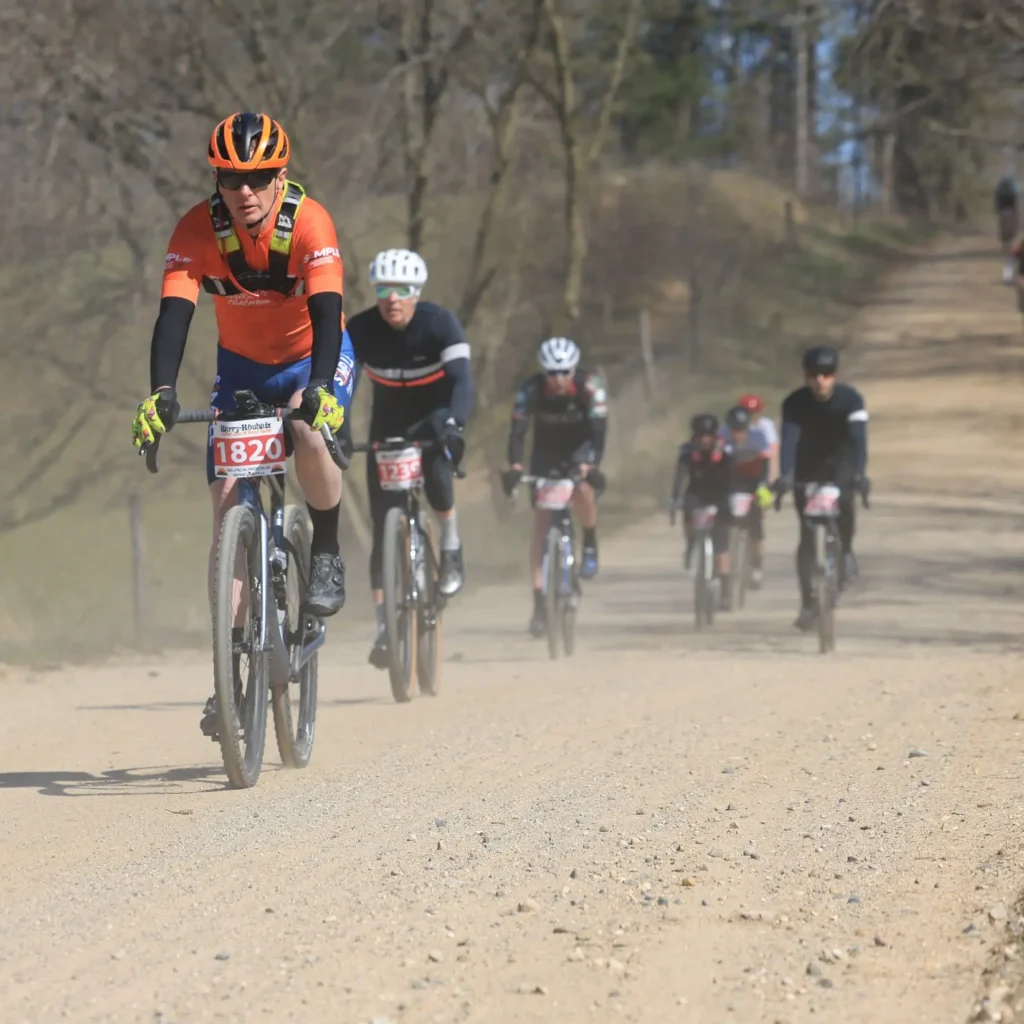Three Ways to Ride Faster for Longer to Maximize Your Gravel Racing Performance
In gravel racing, generally the longer you can maintain riding close to your functional threshold power (FTP) , the faster you’ll be over the course.
So at a certain point in your training, you stop trying to increase your functional threshold power (FTP) and work to increase the time you can ride near or at FTP.
That means increasing your Time to Exhaustion (TTE) or, said in a different way, extending your time at FTP.
If you are able to hold your FTP for a long time, you’ll have more fitness to stay in your group throughout the race.
Plus you’ll be able to hold off fatigue for longer, allowing you to push through tough spots in the race.

FTP is a made-up number but it can help to guide our training
First of all, as we’ve talked about in past articles, FTP is kind of a made-up number.
It’s the power you are supposed to be able to hold for 60 minutes.
However, FTP does not correlate to any kind of physiological response in your body.
What it does, though, is give all of us a reference point for our training.
So if we have some sense of what we can do for an hour, we can shape our training plan to either increase it or extend our time there.
Here are three ways we’ve discussed to increase your FTP for gravel racing:
- High-Intensity Interval Training (HIIT): HIIT workouts consist of short, intense bursts of exercise followed by periods of rest or lower intensity exercise. Research has shown that HIIT can improve aerobic capacity and increase FTP. One study found that just six sessions of HIIT over two weeks improved FTP by nearly 5%.
- Progressive Overload: This training method involves gradually increasing the workload over time in order to stimulate adaptation and improve performance. Research has shown that progressive overload can help increase FTP. One study found that a six-week training program that gradually increased the workload led to a 20% increase in FTP.
- Long, Steady Rides: While high-intensity training is important for improving FTP, longer steady rides can also be beneficial. Research has shown that longer rides at a moderate intensity can improve endurance and increase FTP. One study found that adding one long ride per week to a training program resulted in a 10% increase in FTP.
Increasing time at FTP helps you ride faster for a longer time
However, at some point in our training, increasing FTP is increasingly challenging.
So we want to increase the amount of time we can ride at FTP, which is can be more easily accomplished.
One of the most effective ways to train for gravel race is to do workouts that simulate the demands of a race.
By doing these types of workouts, you may increase your FTP, but you’ll also learn how to better pace yourself during a race.
A study published in the International Journal of Sports Physiology and Performance found that a six-week training program specifically designed for a gravel race improved power output and VO2 max in trained cyclists.
Here are some key workouts designed specifically to extend your time at FTP to race gravel
- Tempo Training: Tempo training involves riding at a steady pace below your FTP. This type of training can help improve your body’s ability to use fat as fuel and enhance endurance. Research has shown that tempo training can increase the time to exhaustion at FTP. For example, we might do two or three 10-minute tempo intervals in the middle of an endurance ride to create a little more training stress.
- Over-Under Intervals: Over-under intervals involve alternating between efforts just above and just below FTP. This type of training can help improve your ability to tolerate higher levels of lactate and delay the onset of fatigue. Research has shown that over-under intervals can increase the time to exhaustion at FTP. We do a few different types of over-unders, including 30 seconds above, two-and-a-half minutes under or one minute over and four minutes under.
- Progressive Long Rides: Progressive long rides involve gradually increasing the time spent riding at or slightly below FTP over several weeks. This type of training can help improve aerobic capacity and muscular endurance. Research has shown that progressive long rides can increase the time to exhaustion at FTP. Generally, long endurance rides form the basis of all of our training.
Strength training keeps you strong to manage increased training and demands of riding on gravel
Strength training can be beneficial for cyclists in improving overall fitness and enhancing riding performance, but its direct impact on FTP may not be as significant as other types of cycling-specific training such as high-intensity interval training, tempo training, and progressive long rides.
However, research has shown that adding a strength training program to a cycling training regimen can lead to improvements in power output, muscular endurance, and overall riding performance.
Specifically, strength training has been found to improve one’s ability to produce and sustain power during maximal efforts and submaximal efforts.
In addition, strength training can help cyclists reduce their risk of injury by improving muscle imbalances and increasing overall body strength, stability, and flexibility.
A study published in the Journal of Strength and Conditioning Research found that adding resistance training to a cycling program improved power output and maximal oxygen uptake (VO2 max) in trained cyclists.
Here are four ways strength training can improve your capacity to ride longer at your FTP
- Improve power output: When you’re riding at high intensities, power is key. Strength training can help improve your power output so that you can maintain a high intensity for longer periods of time.
- Increase muscular endurance: Muscular endurance is important for sustaining a high level of activity over an extended period of time. Strength training can help increase muscular endurance so that you can ride at a higher FTP for longer periods of time.
- Improve pedaling efficiency: Efficiency is key when it comes to cycling. The more efficient you are, the less energy you’ll expend while riding. Strength training can help improve pedaling efficiency so that you can ride at a higher FTP with less effort.
- Increase mitochondrial density: Mitochondria are responsible for producing energy in the body. The more mitochondria you have, the more energy you’ll be able to produce. Strength training can help increase mitochondrial density so that you can ride at a higher FTP for longer periods of time.
Recovery is another critical tool to extend your time at FTP
https://simpleendurancecoaching.com/three-researched-recovery-tools-for-runners-and-cyclists-to-improve-performance/Recovery time is crucial to maintaining your FTP.
If you do not take the time to recover properly, your FTP will suffer and you will not be able to race at your best. Here are some tips to help you extend your FTP:
- Make sure you are getting enough sleep. Sleep is when your body recovers and rebuilds itself. Without proper sleep, your body will not be able to recover properly and your FTP will suffer.
- Eat a healthy diet. Eating a nutritious diet helps your body recover from workouts and maintain a high level of fitness. And if you’re doing a lot of extensive FTP training, you’ll probably need to eat more than you think you do!
- Take active recovery days. Active recovery days are days where you do light exercise or no exercise at all. This allows your body to fully recover from the previous day’s workout and prepare for the next one.
- Use compression garments. Compression garments can help reduce swelling and promote blood flow, which aids in recovery. At the very least, sitting around wearing compression gear helps you relax!
Eat enough to fuel your workouts
When it comes to nutrition, there are a few key strategies to keep in mind during training.
First, it’s important to get enough calories.
This will help your body maintain energy levels and recover from workouts.
One of the mental challenges of clients who are trying to lose weight happens when I tell them to eat more!
Second, make sure you’re getting enough protein.
This will help your muscles repair and grow.
Third, eat a variety of healthy foods.
This will ensure you’re getting all the nutrients your body needs.
Plus, you need to stay hydrated by drinking plenty of water or electrolyte-rich beverages.
If you follow these nutrition strategies during training, you’ll be well on your way to maximizing your gravel race performance!
Practice your bike handling skills
In addition to increasing your FTP and endurance, another important aspect of gravel racing is technical skill.
Unlike road cycling, gravel racing involves riding on unpaved surfaces and navigating rough terrain.
So it’s important to work on your bike handling skills.
This can include practicing cornering, descending, and riding on uneven terrain.
A study published in the International Journal of Sports Physiology and Performance found that mountain bike-specific skill training improved performance in a cross-country mountain bike race.
Three things to consider when training to extend your time at FTP during a gravel race:
- Do specific workouts like over-unders to improve your ability to process lactate during hard efforts.
- Maintain your strength training to handle both increased training loads and the physical demands of racing on gravel.
- Make sure you eat enough and get enough sleep to recover enough to keep training!
Need more on how to maximize gravel racing performance?
Sign up for Virtual Coffee so we can discuss your goals, ask questions, and talk about making your endurance training more effective, fun, and Simple. It’s completely free!
Get a free Core Strength and Stability training video when you opt-in to receive my weekly blog posts about what works in endurance sports.
Paul Warloski is a:
- USA Cycling Level 3 Coach
- RRCA Running Coach
- Training Peaks Level 2 Coach
- RYT-200 Yoga Instructor
- Certified Personal Trainer




